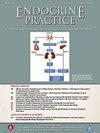1型糖尿病的非浸入型血:病理生理学、并发症和治疗策略。
IF 3.7
3区 医学
Q2 ENDOCRINOLOGY & METABOLISM
引用次数: 0
摘要
非下降血压(BP)模式,其特征是睡眠时间BP与清醒时间值相比下降不到10%,在1型糖尿病(T1DM)患者中普遍存在,并与心血管(CV)风险增加有关。本文综述了T1DM非倾斜模式的患病率、病理生理机制、并发症和治疗策略。非浸渍模式与心脏自主神经功能差、蛋白尿率高、糖尿病肾病的早期标志物和动脉僵硬度增加有关。它还与全因死亡率增加两倍有关。尽管具有临床意义,但对于非糖尿病患者T1DM的具体治疗建议尚无共识。虽然一些研究表明,睡前服用抗高血压药物,如ACE抑制剂和血管紧张素II受体阻滞剂,可以改善浸入模式并减少心血管事件,但这些发现主要基于对一般高血压人群的研究。新出现的证据也表明维生素D补充和生活方式干预在改善血压变异性方面的潜在作用。需要进一步的研究来制定针对非T1DM患者的循证管理策略,旨在降低CV风险并改善长期预后。本文章由计算机程序翻译,如有差异,请以英文原文为准。
The Nondipping Blood Pattern in Type 1 Diabetes Mellitus: Pathophysiology, Complications, and Management Strategies
Background
The nondipping blood pressure (BP) pattern, characterized by a less than 10% decline in sleep-time BP compared to awake-time values, is prevalent in individuals with type 1 diabetes mellitus (T1DM) and is associated with increased cardiovascular (CV) risk.
Case Report
This review discusses the prevalence, pathophysiological mechanisms, complications, and management strategies of the nondipping pattern in T1DM. The nondipping pattern is linked to poor cardiac autonomic function, higher rates of albuminuria, early markers of diabetic kidney disease, and increased arterial stiffness. It is also associated with a two-fold increase in all-cause mortality.
Discussion
Despite its clinical significance, there is no consensus on specific treatment recommendations for nondippers with T1DM. While some studies suggest that bedtime administration of antihypertensive medications, such as ACE inhibitors and angiotensin II receptor blockers, can improve the dipping pattern and reduce CV events, these findings are primarily based on studies in the general hypertensive population. Emerging evidence also indicates a potential role for vitamin D supplementation and lifestyle interventions in improving BP variability.
Conclusion
Further research is needed to develop evidence-based management strategies tailored to nondippers with T1DM, aiming to reduce CV risk and improve long-term outcomes.
求助全文
通过发布文献求助,成功后即可免费获取论文全文。
去求助
来源期刊

Endocrine Practice
ENDOCRINOLOGY & METABOLISM-
CiteScore
7.60
自引率
2.40%
发文量
546
审稿时长
41 days
期刊介绍:
Endocrine Practice (ISSN: 1530-891X), a peer-reviewed journal published twelve times a year, is the official journal of the American Association of Clinical Endocrinologists (AACE). The primary mission of Endocrine Practice is to enhance the health care of patients with endocrine diseases through continuing education of practicing endocrinologists.
 求助内容:
求助内容: 应助结果提醒方式:
应助结果提醒方式:


